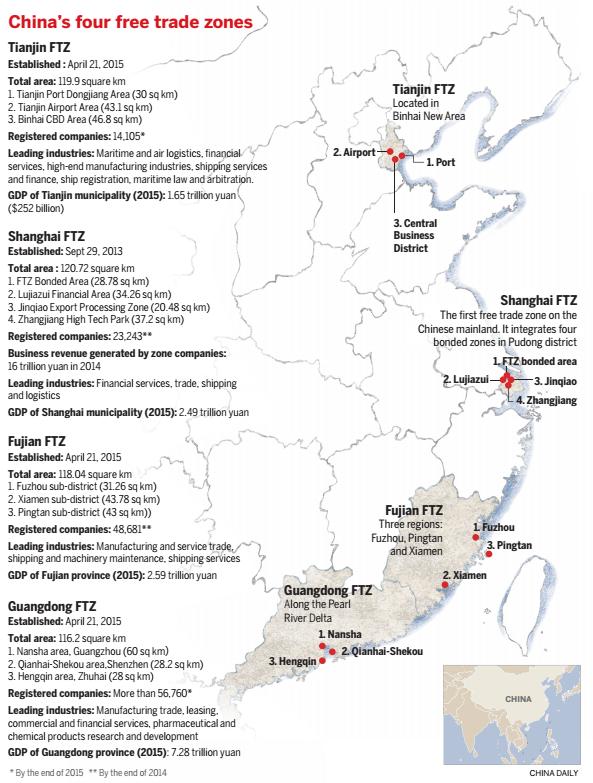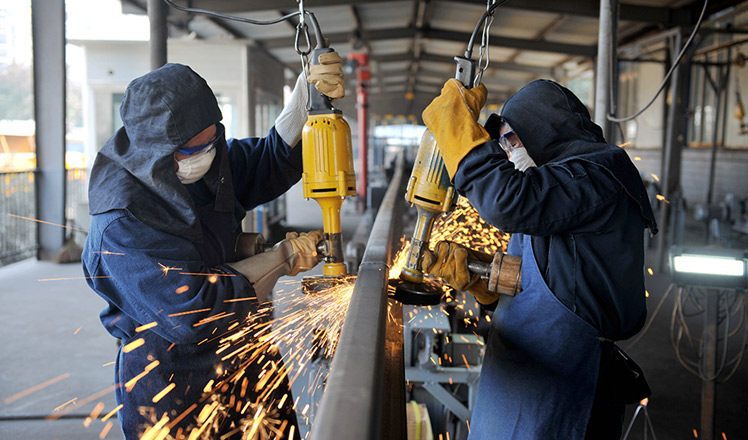FTZs to lead the way
Updated: 2016-02-22 03:27
By ZHONG NAN in Shanghai and LIU CE in Shenyang(China Daily)
|
||||||||

Local trade areas to feature prominently in next stage of the country's growth
Every stage of China's development can be likened to a sporting event played by local governments.
Since the start of the 1990s, the areas in which local authorities have competed include foreign direct investment, new airports with direct flights to popular overseas destinations, sprawling urban plans featuring exotic public buildings or office buildings, and high-speed rail services.
But what next, with the economy undergoing a difficult transition and almost every industry seeing a slowdown in growth?
News emerging from provincial-level policymaking meetings held before the annual session of the National People's Congress in March is that setting up local free trade zones will mark the next stage of the nation's development.
Local governments will embark on a new round of competition to obtain central government approval for such zones and to show who can run a local FTZ most successfully.
Commerce officials say that the competition will probably continue throughout the nation's 13th Five-Year Plan (2016-20).
Also called tariff-free zones, FTZs are areas within which goods can be imported, processed and exported without going through customs inspections. Foreign investors can set up facilities in industries that are restricted elsewhere in the country.
FTZs are designed to provide greater access and convenience for foreign companies to expand in China and for Chinese companies to move money abroad — in diverse services and financial operations, as well as in manufacturing.
For foreign enterprises from developed economies, FTZs can help establish beachheads quickly in important services such as health and education, said Liu Chenyang, a researcher with the APEC study center at Nankai University, Tianjin.
As many as 20 of the 31 provinces, municipalities and autonomous regions on the Chinese mainland have either made plans or filed proposals with the central government to establish FTZs.
Liaoning, Henan and Hai-nan provinces and the Ningxia Hui autonomous region have officially included their concepts for local FTZs into their plans for 2016.
The chance for these provinces to get the green light from the central government seems good, development specialists and officials say. A new batch of FTZs is expected to be finalized in the first half of the year, although not all provinces will be satisfied.
The nation right now has four FTZs, all along its coastline. It established its first pilot FTZ in Shanghai in August 2013, and three more in Tianjin, Fujian and Guangdong in April.
In December, the State Council issued its "Opinions on Speeding up the Implementation of FTZ Strategy", which promised to build more FTZs.
Most likely, the new batch will give priority to inland areas that play a key role in the Belt and Road Initiative, connecting with countries across Eurasia.
Tang Wenhong, director-general of the Ministry of Commerce's Department of Foreign Investment Administration, said the new batch is also expected to increase China's competitiveness in the Asia-Pacific region.
Li Xi, Party chief of Liaoning province, said he is expecting the central government to approve the China (Dalian) Pilot Free Trade Zone quickly so that it can help the longtime industrial province reverse its rapid decline in business activity.
"The Dalian FTZ is designed not just as a copy of others but as one that is more regionally integrated, targeted and differentiated in its own functions, backed by a strong industrial foundation and strategic positioning" compared with Japan, Russia, Mongolia and the Korean Peninsula, Li said.
A free-trade zone in Dalian — an international shipping center and regional finance center in Northeast Asia — could boost trade volume between overseas markets and China's northeastern provinces and the eastern Inner Mongolia autonomous region, according to Bai Ming, a researcher at the Beijing-based Chinese Academy of International Trade and Economic Cooperation.
In particular, it could help Liaoning, which has suffered from a decline in overseas demand and rising wages, to reorient its business for the 21st century.
"For sustainable growth, local officials must pay attention to job creation," Bai said. "They should design new FTZs imaginatively so that they are more regionally integrated. They should not blindly copy existing FTZs."
At the moment, FTZs make up only a tiny part of China's economy. But they represent a future scenario for success. In the long run, economists expect the entire country's economy and economic regime to become more like today's FTZs.
In a few years, experts say, they will help China get used to a more competitive and more collaborative global business environment.
Contact the writers at zhongnan@chinadaily.com.cn
- Missing children found safe in nearby village
- Rich Chinese splurge on sportswear as luxury's lustre dims
- Urgent remedy sought for pediatrician shortage
- China starts safety check for school buses as new semester draws near
- Ticket scalpers face crackdown at Beijing hospitals
- Judicial DNA test in hot demand after policy change
- Classic Car Show kicks off in London
- Balkan, Austria police agree to register refugees on Macedonian border
- Turkey blames Kurdish militants for Ankara bomb; vows reprisals
- Britain scrambles fighters to intercept Russian bombers
- Chinese community to protest against Peter Liang's verdict
- Car bomb attack on military in Turkish capital kills 28

 Chinese photographers' work shines in major photo contest
Chinese photographers' work shines in major photo contest
 88th Academy Awards Governors Ball Press Preview
88th Academy Awards Governors Ball Press Preview
 Egg carving master challenges Guinness World Record
Egg carving master challenges Guinness World Record
 Missing children found safe in nearby village
Missing children found safe in nearby village
 Madonna's world tour lands in Hong Kong
Madonna's world tour lands in Hong Kong
 Producing high-speed rail tracks
Producing high-speed rail tracks 
 Surreal world created by Canadian photographer
Surreal world created by Canadian photographer
 Lanterns light up the night across China
Lanterns light up the night across China
Most Viewed
Editor's Picks

|

|

|

|

|

|
Today's Top News
Investigation for Nicolas's campaign
Will US-ASEAN meeting be good for region?
Accentuate the positive in Sino-US relations
Dangerous games on peninsula will have no winner
National Art Museum showing 400 puppets in new exhibition
Finest Chinese porcelains expected to fetch over $28 million
Monkey portraits by Chinese ink painting masters
Beijing's movie fans in for new experience
US Weekly

|

|







